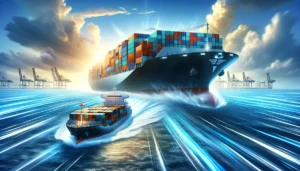The unstoppable growth of technology has driven countless industries, including freight forwarding, to invest heavily in digitalization. Traditional freight forwarding processes for shipping goods just don’t cut it anymore. If you want to be a strong competitor in today’s especially challenging logistics landscape, the key to success hinges on your ability to evolve with technology.
In this blog post, we’ll be discussing what digital transformation is exactly, why it’s imperative for freight forwarders and NVOCCs (learn how to apply for NVOCC license here), and what you need to pay attention to moving forward into the future.
Afraid of being irrelevant 3 years from now?
Benefits of Digital Freight Forwarding
In order to successfully step up their game and drive cost savings, freight forwarders must embrace the trend of digitalization. Those who fail to jump on board in time will eventually get left behind by their competitors who were smart enough to get in on the front-end of new technology. Here’s why:
Freight forwarding clients, who are consumers themselves, already order products on Amazon to be delivered on that same day. These heightened expectations in the B2C sector are going to eventually bleed over into the B2B sector. So, it’s important for forwarders to understand what customers are looking for from them, whether it’s a global network of carriers, instant freight quotes, better freight visibility, or more efficiency.
Fortunately, digitalization allows businesses to streamline their processes and improve productivity, so they can meet and even exceed the expectations of customers. By switching from phones or fax machines to messaging apps or emails to connect with clients, digital freight forwarders can respond much faster. Also, digitizing all of your documents instead of manually entering in information automates the documentation process, which further speeds things along and frees up more time for you to focus on the more critical parts of your business.

Common Mistakes To Avoid
Even though countless businesses have started automating outdated supply chain functions, a good number of them come across obstacles along the way, and only a few manage to achieve their goal. Here are some of the most common mistakes freight forwarding companies make when integrating new technology:
Internal Resistance
Change can be scary. It’s understandable that a lot of people might want to just stick to their tried and true methods; however, it’s crucial that freight forwarders overcome this tendency to stay with what’s safe. When you get everyone in your organization on the same page about your plans for adopting digital trends, you’ll have a lot more luck adapting to new systems and avoiding internal resistance.
Inefficient Collaboration
Collaboration between different departments within a company has never been easy. Each department has its own set of objectives, and there also might be conflicts of interest. Inefficient interdepartmental communication causes a lot of damage though, when you’re in the middle of a significant transformation.
Lack of Cybersecurity
In the past, businesses mainly focused on internal IT security, but with emerging cloud-based software, AI, and IoT applications, there’s a lot more external risk involved. This is why it’s important to ensure there are additional security measures that will protect your valuable information from outside threats. To learn more about cybersecurity in logistics, click here.
Ignoring Startups
Many freight forwarders fail to realize the opportunities that come along with including new businesses in their digital transformation strategy. There are many benefits to working with startups. For one, they typically move at a faster pace and are pretty flexible in comparison to more established companies. They’re constantly trying new systems, products, and services without having to go through the lengthy integration process that’s often unavoidable for most enterprises.
For another, it’s definitely riskier and more costly for older companies to digitally transform their business models on their own without the help of a startup. Involving startups and experiencing a different business culture can help give you a diverse perspective and open up doors that wouldn’t otherwise be a possibility.
Freight forwarding is still thought of as one of the most traditional industries out there. Despite this reputation, it’s inevitably been affected by digitization like everyone else. To survive in this technological age, forwarders need to get out of their comfort zone and fully embrace this trend. While there are definitely other factors that might hurt the transformation process, taking tips like these into account will help you better prepare for integrating new technology and increase your chances of success.
Create a Digital Platform That Provides Real-Time Visibility for Customers With GoFreight
Becoming a digital freight forwarder doesn’t have to be overwhelming. With the right forwarding technology on your side, you can seamlessly transition into the next phase of your business and guarantee a lucrative ROI for yourself. To lower costs, increase revenue, and unleash your full potential, request a free GoFreight demo today.



